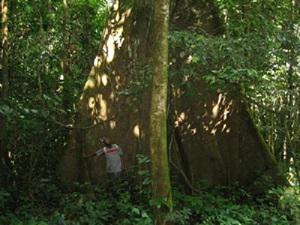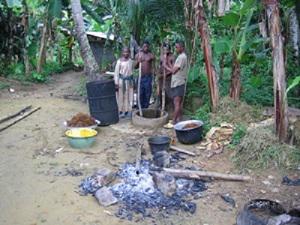Emmanuel Nuesiri
Other projects
12 Feb 2009
Establishing a Forest Monitoring Programme for the Bimbia-Bonadikombo Community Forest (BBCF)
This project aims to build the biodiversity conservation capacity of local communities in the Upper Banyang forest area of Cameroon, which is part of the Cross-Sanaga-Bioko coastal forest ecoregion.

Ecological survey in Tali-Bara forest.
This forest area is both a high value conservation forest (HVCF) and the primary source of livelihoods for the communities in the area. The forest area is home to endangered wildlife species including the African Forest Elephant (Loxodonta cyclotis) and the Chimpanzee (Pan troglodytes). It’s also rich in the high value tropical hardwood Lophira alata commonly known as Ekki or Azobe or Kaku West. Lophira alata is listed in the ‘Good Wood Web Guide’ as vulnerable specie at risk of extinction. Thus the forest area has attracted a lot of attention.

Local manufacture of Palm Oil.
In 1996, the Government of Cameroon (GoC) in recognition of the high conservation value of this forest area created the 656 km2 Banyang-Mbo Wildlife Sanctuary (BMWS). The sanctuary is a co-managed protected area under the Ministry of Fauna and Flora (MINFOF) with a management team technically and financially supported by the Wildlife Conservation Society (WCS). In 2002, the GoC granted a 728 km2 logging concession to the north of the BMWS to Wijma, a Dutch logging company that specialises in the international trade in Lophira alata. Sandwiched between the logging concession and the wildlife sanctuary is a forest corridor with a number of communities (including Ebensuk and Mambo) who have traditionally and still do depend primarily on the forest for their livelihoods.
The establishment of the BMWS in 1996 and the subsequent restriction of use rights of communities adjacent to the sanctuary raised concerns in these communities about their forest future. Aware that the 1994 forestry law allows communities to apply for and obtain legal managerial rights over their communal forest, the people of Ebensuk requested assistance from this researcher to enable them obtain their own community forest. A research team was put together and with funding from Rufford set to work in December 2004. Initial results show that Ebensuk and Mambo’s communal forest are inside the logging concession and unavailable as community forest. This is because the 1994 forestry law bars communities whose forestland falls within a concession from obtaining a community forest.
While carrying out research activity in Ebensuk, two other neighbouring communities, Tali and Bara approached research team requesting for assistance in obtaining their own community forests. Preliminary results from on-going research in Tali and Bara show that these have sufficient communal forestlands to apply for community forest status. However before these communities can submit an application file to the GoC, a market based economic assessment of the livelihood resources in their communalforest has to be executed. Our research thus far has provided us with achecklist of forest resources of major livelihood significance in their communal forest. The next step is to assess the economic potential of these forest products to significantly contribute to poverty alleviation and biodiversity conservation in the area.